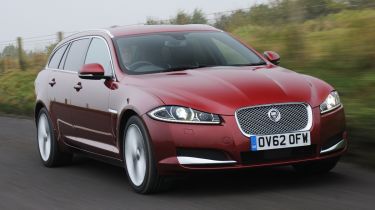Jaguar XF Sportbrake 2.2
The long-awaited Jaguar XF Sportbrake estate is set to take on BMW, Mercedes and Audi
The XF Sportbrake isn’t the quickest, most spacious or even the sharpest premium estate on sale, but that isn’t to say it’s not fantastic. While many of its competitors are very good at one thing above everything else, the Jaguar has a solid mix of abilities that cements it as a great all-rounder. Our biggest issue concerns the rattly diesel engine – but going for the 3.0-litre V6 version would solve that issue.
It's taken four years and one facelift, but the Jaguar XF is finally available as an estate.
The new XF Sportbrake aims to tempt premium estate buyers who are already spoiled for choice, with the sharp-handling BMW 5 Series Touring, the ultra-spacious Mercedes E-Class Estate and classy Audi A6 Avant. So what is it that will make the Sportbrake stand out?
Most obvious is the way it looks. The XF’s svelte front end is unchanged and Jaguar has neatly incorporated the more practical rear, with a subtle spoiler and blacked-out D-pillars – a trick borrowed from the XJ.
However, the XF Sportbrake isn’t the most practical car in this class; in fact, it ranks pretty low. Although its 550-litre boot is 50 litres larger than the saloon’s, it’s 145 litres down on the E-Class Estate’s and trails the Touring’s by 10 litres. It claws back some credibility when you fold the rear seats, though, with the 1,675-litre maximum capacity eclipsing the BMW’s by five litres.
More reviews
Neat boot touches include underfloor storage, adjustable load rails and shopping hooks. And the luggage area feels just as luxurious as the rest of the cabin thanks to deep carpets, LED lighting and a stainless steel loading guard. Plus, all but basic SE models get a powered bootlid.
Most cars sold in this class use diesel, so it makes sense that the Sportbrake should be offered only with a 3.0-litre V6 and the relatively new 2.2-litre four-cylinder diesels. Our car had the latter, and while this 197bhp engine isn’t as smooth as the V6, it still has lots of punch; 0-62mph takes 8.8 seconds and the eight-speed auto box blurs gearshifts.
A hint of diesel rattle under hard acceleration is the only negative in an otherwise relaxing cabin. The ride is as supple as the saloon’s, and standard self-levelling rear air-suspension ensures good balance whatever load you’re carrying.
It also means the estate loses nothing dynamically to the four-door. But that’s not to say it’s the sharpest car in this class; the steering could be faster and it needs more feel. In terms of driving appeal, the XF sits between the fun 5 Series Touring and relaxing E-Class Estate.
That’s where the Sportbrake sits for economy, too. The 2.2-litre diesel manages 55.4mpg, while the BMW achieves 57.6mpg. The Merc, meanwhile, has slightly worse fuel returns of 54.3mpg.
Add it all together and you’ve got a premium estate that holds its own against all class rivals. Unlike other contenders, the XF doesn’t have a particular USP, but it mixes and matches the best parts of its peers to create a capable, if not quite brilliant, all-rounder.



